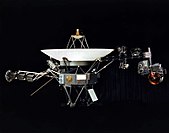Moon Larissa
Larissa, also known as Neptune VII, is the fifth-closest inner satellite of Neptune.
It is named after Larissa, a lover of Poseidon (the Greek equivalent of the Roman god Neptune).
 Larissa from Voyager 2 | |
| Discovery | |
|---|---|
| Discovered by | Harold J. Reitsema, William B. Hubbard, Larry A. Lebofsky, and David J. Tholen |
| Discovery date | May 24, 1981 |
| Designations | |
Designation | Neptune VII |
| Pronunciation | /ləˈrɪsə/ |
Named after | Λάρισσα Lārissa |
| S/1989 N 2 S/1981 N 1 | |
| Adjectives | Larissean, Larissan, Larissian /ləˈrɪs(i)ən/ |
| Orbital characteristics | |
| Epoch 18 August 1989 | |
| 73 548.26 km | |
| Eccentricity | 0.001393 ± 0.00008 |
| 0.55465332 ± 0.00000001 d | |
| Inclination |
|
| Satellite of | Neptune |
| Physical characteristics | |
| Dimensions | (216±6) × (204±16) × (168±4) km |
Mean radius | 97±3 km |
| 118236.98 km2 | |
| Volume | ~3.64×106 km3 |
| Mass | ~(0.19–5.7)×1018 kg |
Mean density | ~0.052–1.57 g/cm3 |
| ~0.001–0.054 m/s2 | |
| ~0.015–0.095 km/s | |
| synchronous | |
| zero | |
| Albedo | 0.09 |
| Temperature | ~51 K mean (estimate) |
| 21.5 | |
Larissa is also the eponymous nymph of the city in Thessaly, Greece.
Discovery

Larissa was first discovered by Harold J. Reitsema, William B. Hubbard, Larry A. Lebofsky and David J. Tholen, based on fortuitous ground-based stellar occultation observations on May 24, 1981. It was given the temporary provisional designation S/1981 N 1 and its supposed existence was announced on May 29, 1981. The moon was later recovered and confirmed to be the only object in its orbit during the Voyager 2 flyby in 1989 after which it received the additional designation S/1989 N 2 on August 2, 1989. The announcement by Stephen P. Synnott spoke of "10 frames taken over 5 days", which gives a recovery date sometime before July 28. The name was given and then confirmed by the International Astronomical Union on September 16, 1991.
Characteristics


Larissa is the fourth-largest satellite of Neptune. It is irregular (non-spherical) in shape and appears to be heavily cratered, with no sign of any geological modification. It is likely that Larissa, like the other satellites inward of Triton, is a rubble pile re-accreted from fragments of Neptune's original satellites, which were disrupted by perturbations from Triton soon after that moon's capture into a very eccentric initial orbit.
Larissa's orbit is nearly circular and lies below Neptune's synchronous orbit radius, which means it is slowly spiralling inward due to tidal deceleration and may eventually impact Neptune's atmosphere, or break up into a planetary ring upon passing its Roche limit due to tidal stretching, similarly to how Triton will eventually collide with Neptune or break into a planetary ring.
Exploration

Larissa has only been visited once by Voyager 2. The probe was able to get some photographs with details of Larissa, showing its cratered surface; unlike the other inner moons of Neptune that only appeared as dots or smudges.
Notes
References
External links

This article uses material from the Wikipedia English article Larissa (moon), which is released under the Creative Commons Attribution-ShareAlike 3.0 license ("CC BY-SA 3.0"); additional terms may apply (view authors). Content is available under CC BY-SA 4.0 unless otherwise noted. Images, videos and audio are available under their respective licenses.
®Wikipedia is a registered trademark of the Wiki Foundation, Inc. Wiki English (DUHOCTRUNGQUOC.VN) is an independent company and has no affiliation with Wiki Foundation.